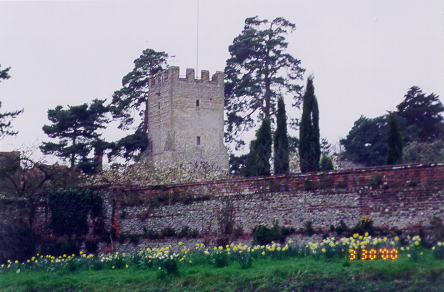
|
 |
Alexander "Sasha" Volokh
My tour of the Middle Ages, part II
Greys Court, England, March 29, 2000

Above: Greys Court, Henley-on-Thames
"In the grounds of the Tudor mansion known as Greys Court, where the Earl and Countess of Somerset
were kept in the custody of Sir William Knollys after their conviction for the murder of Sir Thomas
Overbury, stand the scanty brick and flint remains of a fortified manor house built here by the de
Grey family in the fourteenth century.
"They had owned the manor since the time of the Domesday survey, and Sir John de Grey was licensed
to crenellate in 1347.
The property consisted of a rectangular courtyard surrounded by a curtain wall with an octagonal
tower at each corner, and against the west wall a four-storey tower-house or keep, built partly of
brickwork which may well have been the earliest in Oxfordshire.
The 'keep' had small square-headed windows, and all the towers except one were topped with
battlements.
Between the de Greys who built this house and the Knollyses who built the later one, the place was
owned by the Lovell family.
"The Saxon village of Rotherfield was already here when the de Greys came.
The name comes from 'Hryther' and means land where cattle graze.
After the Conquest it soon became known as Rotherfield Greys.
Walter de Grey was Archbishop of York in the time of Henry III, and Sir Robert de Grey helped Edward
I subdue the Welsh.
In due course the family was granted a barony, but nearly lost it when the second Lord Grey offended
Edward III by drawing a knife in anger in the king's presence.
In any case, the barony was short-lived, as the fifth Lord Grey died without issue in 1387.
"The house itself survived until the early sixteenth century, when the new house was built using
material from the old one and incorporating some parts of it in the new building, in particular the
kitchen.
A drawing of about 1600 shows the outer walls and two gatehouses intact, and the foundations of these
can be detected in the parched grass in very dry summers.
"Rotherfield Greys is two miles west of Henley-on-Thames, and Greys Court lies north of the
village, well signposted, between A423 and B481.
The house and ruins are owned by the National Trust, and there is a car park at the site.
A well-known feature of the house is a donkey wheel used to draw water from the well, like that at
Carisbrooke Castle.
SU 725834."
Brian J. Bailey, Romantic Ruins of England and Wales (1989), p. 210

Above: The sheep
This is all Jessica and I got to see at Greys Court, since it's closed in the winter and opens in
April.
Note the date at the top of this page -- March 29.
There was no house access, but a public footpath nearby, so we got to have a nice walk around the
house and see the sheep.
Back to London
Advance to Wallingford
Return to places page
Return to home page
|